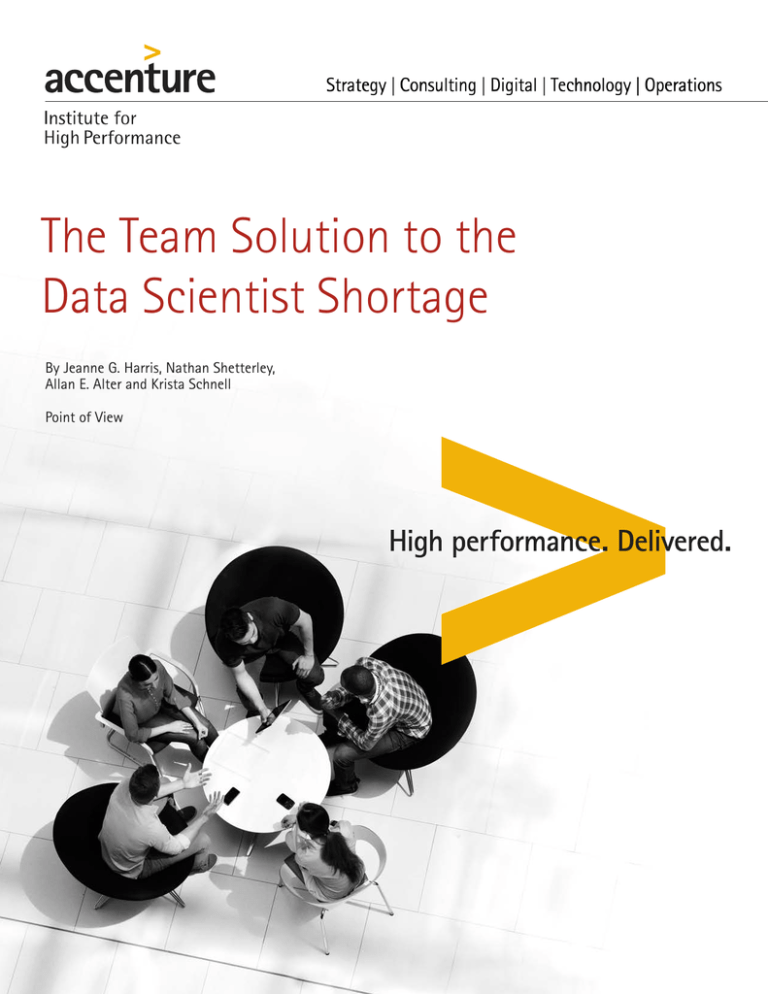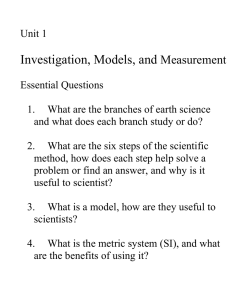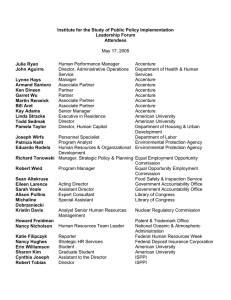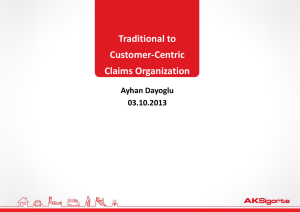
The Team Solution to the
Data Scientist Shortage
By Jeanne G. Harris, Nathan Shetterley,
Allan E. Alter and Krista Schnell
Point of View
The Team Solution to the Data Scientist Shortage
Today’s data scientist shortage
won’t go away soon, yet
companies need them more
than ever to leverage the value
of big data. The solution is to
build teams of data scientists
instead of seeking soloists.
2 | Accenture Institute for High Performance | Copyright © 2013 Accenture. All rights reserved.
The Team Solution to the Data Scientist Shortage
If you are looking for brilliant, top-tier
data scientists to take your company to big
data nirvana, we have news for you. Unless
you run a hotshot Silicon Valley company,
chances are enough of them aren’t going
to walk through your door. There’s a more
realistic approach for the rest: divide up
the job and conquer.
Data scientist is the most common term
for the often PhD-level experts who operate
at the frontier of analytics, where data sets
are so large and the data so messy that
less-skilled analysts using traditional tools
cannot make sense of them. But they are
more precisely described as data engineerscientist-manager-teachers.
Like any curious scientist, they test theories
by exploring and running experiments
with data. As computer scientists and
programmers, they design the intricate
models, algorithms and visualizations
that can help companies distill insights
from huge volumes of chaotic data.
Data scientists also do the work of
engineers. They acquire external data sets
to supplement internal data, and often
manage the data they use and maintain
the systems which host it. And as their
companies’ top experts on generating
analytical insights, they guide, train and
sometimes manage other quantitative
professionals, and help general managers
understand what they need to know about
big data-era analytics.
“Being a data scientist is not only about
data crunching. It’s about understanding
the business challenge, creating some
valuable actionable insights to the data,
and communicating their findings to
the business,” says Jean-Paul Isson, the
global vice president of predictive analytics
and business intelligence at Monster
Worldwide, Inc.
Data scientists’ behind-the-scenes
influence can be massive. LinkedIn
Corp.’s data scientists figured out how
to recommend “people you may know”
to the site’s users, thereby launching a
feature that has boosted its page views
by millions.1 The data scientists at Monster
Worldwide improved customer retention
among job-listing employers by 15 percent
within a year and boosted spending too,
in part by benchmarking the performance
of their listings against similar job postings
and offering guidance on how to improve
performance.2 Zest Finance, a financial
services startup led by former Google Inc.
and Capital One Financial Corp. executives,
claims it can reduce underwriting risk for
credit issuers by 40 percent through big
data analysis.3
Data scientists are in high demand, but
research by the Accenture Institute for
High Performance has found the world is
facing a severe shortage. There is simply
not enough PhD talent to fill the jobs. The
shortage is especially severe in the U.S.
where 80 percent of new data scientist
jobs created between 2010 and 2011 have
not been filled, according to our analysis.
And the shortage is getting worse. One
reason is that data scientists require
a scarce combination of skills. They
must master advanced statistical and
quantitative methods and tools, along
with the new computing environments,
languages and techniques for managing
and integrating large data sets. Data
scientists must also possess industry
knowledge and business acumen to create
models and solve real-world problems.
And they need excellent communication
and data visualization abilities in order to
explain their models and findings to others.
That combination is hard to find.
“Being a data scientist is not only about data
crunching. It’s about understanding the business
challenge, creating some valuable actionable
insights to the data, and communicating their
findings to the business.”
Jean-Paul Isson, Monster Worldwide, Inc.
3 | Accenture Institute for High Performance | Copyright © 2013 Accenture. All rights reserved.
The Team Solution to the Data Scientist Shortage
What’s more, the number of graduates with
the requisite technical skills isn’t keeping
up with rising demand. The U.S. is expected
to create around 400,000 new data science
jobs between 2010 and 2015, but is likely
to produce only about 140,000 qualified
graduates to fill them. While emerging
economies are continuing to produce STEM
talent, the shortage in the U.S. alone will
still exceed the combined surpluses in
China and India combined.4
The analytics talent shortage increases the
workload on any company’s data scientists.
Add to that their mentoring work, and any
project coordinating they must do, and a
scarce resource is stretched like taffy.
The U.S. is expected to create around 400,000
new data science jobs between 2010 and 2015,
but is likely to produce only about 140,000
qualified graduates to fill them.
Training quants to become data scientists
and turning to outside sources can help,
but both have their limits: training can take
years, and many companies cannot accept
the risks of opening up their analytical
innards to outsiders.
data all by themselves. They bring together
a team to design the equipment, run
experiments, do the math and analyze the
data. Likewise, it makes sense to divide the
labor of a data scientist rather than search
for that rare combination in a single person.
But there is another solution which holds
real promise for offsetting the shortage:
Create a team of people who individually
lack the full skill-set of a data scientist, but
as a group possess them all. (See Figure 1.)
When physicists take on a big project, they
do not build super-colliders and analyze the
Monster Worldwide, LinkedIn and PayPal
already employ data scientist teams.
Monster has built up a team of data
crunchers, statisticians, business analysts,
computer scientists and “navigators”
who can explain findings to managers.
LinkedIn organizes its data scientists as
Figure 1: The 8 Skills of Data Scientists
Executives are struggling to find individuals who possess all eight data scientist skills
and abilities. A data scientist team can serve as an alternative.
Quantitative
analyst
Systems
architect
Skillset
Data
team
Advanced analytics
Business acumen
Communication & collaboration
Creativity
Data integration
Data visualization
Software development
Systems administration
Data
scientist
Business
analyst
Software
engineer
Low
Visualization
designer
4 | Accenture Institute for High Performance | Copyright © 2013 Accenture. All rights reserved.
Medium
High
The Team Solution to the Data Scientist Shortage
a product team that includes product
marketers, designers and web developers
along with mathematicians and engineers.5
Mok Oh, PayPal’s former chief scientist,
sought a team of computer science PhDs,
leavened with statisticians and MBAs.
Other companies are taking this teambuilding path. American International
Group, Inc. is assembling a “Science” team
of statisticians, business analysts, project
managers, systems architects and engineers
for its Property and Casualty business.6
The size of these teams will vary: from
a handful of people for pilots and short
tactical projects, to ten, twenty or more
for longer projects and ongoing analytical
work. A small team could include one or
more software engineers and quantitative
analysts who know Hadoop (an open source
computing environment often used for big
data processing) and can write scripts in
the languages used to prepare, integrate,
clean, run and analyze big data such as
Hive and Pig. It could also include a systems
architect to maintain the systems that host
the data, and ensure these systems can
communicate with one another.
Larger teams add specialists to
supplement these roles, dividing the work
between them into narrowly defined tasks:
programmers in Java and Python that write
the commands which prepare data for use,
quantitative analysts who can dig deeper
into the findings to find the insights, and
data visualization specialists who can turn
findings into easy-to-understand graphics
for sharing outside the team. Larger teams
also require project managers/liaisons to
oversee their efforts and coordinate the
team’s work with its sponsors.
On the business skill side, data scientist
teams can also include quantitatively
oriented business analysts and visualization
designers. Business analysts act as business
function experts who understand what
information is most valuable to the
business, and can communicate findings
back to functional managers in language
they understand. They are the most suitable
member of the team to serve as the liaison
with different departments. Visualization
designers are specialists who can effectively
use data to tell stories through graphics.
Another option is to create what Isson calls
a “navigator,” a professional communicator
who shares the data and the team’s
conclusions through straightforward
language and graphics. At Monster, each
business function is assigned a navigator
who serves as its liaison with the team.
Between them, these data scientist
teams will have the necessary knowledge
of the company’s business needs, and
the ability to:
• design statistical models for getting
desired insights out of the data that
is being collected,
• create text mining algorithms for
analyzing unstructured data,
• create machine learning algorithms
for embedding analytics into business
processes,
• clean and convert raw data into formats
that can be used by other tools,
• carry out quality assurance testing
to ensure the models deliver insights
accurately, and
• design easy-to-grasp ways to display
insights through data visualization.
5 | Accenture Institute for High Performance | Copyright © 2013 Accenture. All rights reserved.
Creating teams that are a melting-pot
mixture of complementary hard and soft
skills is the approach Accenture is taking
to build up the scale of its own data
science capacity.
Some of these roles may already exist
within the company under other names or
guises. Companies already have people who
clean data and operate systems, and “data
stewards” who work with business analysts
to manage data and help ensure it’s used
well. Still, it can be difficult to find even
technologists who are familiar with Hadoop
and other Big Data technologies. But these
teams can be aided by tools that simplify
these tasks. These tools are still quite new,
and may not necessarily cover all the work
that data scientist teams need to do. But
as they mature, they will increasingly allow
business analysts with less technical knowhow to be part of a data scientist team.
Consider a team in the retail industry
that’s been charged to improve sales
from recommendations made to its online
customers. The retailer may have stored
massive amounts of data in Hadoop, but
new tools make it possible for business
analysts to still work with the dataset.
New tools such as Pivotal’s HAWQ,
Microsoft Corp.’s PolyBase, Teradata Corp.’s
Aster SQL-H and Cloudera, Inc.’s Impala
The Team Solution to the Data Scientist Shortage
enable programmers who know SQL,
a widely used query language, to prepare
data in Hadoop for analysis. The eponymous
tools from Datameer, Inc., Jaspersoft
Corp. and Pentaho Corp. provide familiar
interfaces such as spreadsheets, or reports
for analyzing data in Hadoop. These tools
remove the need to learn new programming
languages. Business analysts could use such
tools to discover that people who purchase
certain products are much more likely
to buy certain others, and then display
the results through an easy-to-use data
visualization application, such as Tableau
Software’s Tableau Desktop, QlikTech
International AB’s QlikView and TIBCO
Software Inc.’s Spotfire.
Most organizations already have a great
deal of experience managing teams and
projects. But executives should keep the
following points in mind for creating
effective data engineer-scientist teams:
Widen the recruiting pool: Don’t just look
for people who already have these roles
and skills in competing companies. Search
outside your industry, and even outside the
business world. It can sometimes be easier
to find people who have used tools
When everyone is learning new skills from their
teammates and thus furthering their careers,
team members have more reasons to stay put.
to analyze data in the sciences than highly
trained and specialized developers in your
own industry. Restless academics with
strong analytical skills may also be able
to find a new home on a data scientist
team. The same is true with physics
majors, artists and graphic designers.
Physics majors are worth seeking for their
mathematical imagination and highly
speculative minds. Artists, in particular
graphic designers, can bring creativity and
imagination to data visualization. Consider
as well the possibility of including outside
specialists on the team—for example, by
teaming up with a university or tapping a
crowdsourcing service.
Communicate, collaborate, but don’t
necessarily co-locate: These teams need
to work closely together. In an ideal world,
all members work together in the same
location and even room. But companies
should not give up on teams if they cannot
co-locate them. Videoconferencing is just
the start. Remote workers can be paired
up and set up to share the same screen on
their computers, so each can enter text on
the same command line and see the same
windows. And Monster’s dispersed data
scientists follow a common framework
when they produce their findings, says
Isson. “We make sure our people around
the world have common goals, methods
and processes, and a common view of
our market and customer base.” 7
6 | Accenture Institute for High Performance | Copyright © 2013 Accenture. All rights reserved.
Boost effectiveness and retention
through team learning: On a data scientist
team, it’s helpful to encourage members
to pick up skills from other members. Over
time, this creates flexibility; when one
member is unavailable, others can pick up
the slack. It can also create a unit that is
more resistant to attrition. When everyone
is learning new skills from their teammates
and thus furthering their careers, team
members have more reasons to stay put.
In addition, the time-proven wisdom
about managing teams bears repeating:
Data scientist teams, like others, flourish
best when there is effective leadership, a
strong mandate from above and clear goals.
They require a path for taking projects
from design through implementation.
Like many projects in the IT world, they
benefit from working in rapid, iterative
sprints of preparation, analysis and review.
We also recommend starting with short,
low-risk projects to learn the ropes before
tackling longer, more complex ones.
Businesses are long on experience with
managing teams. They will remain short on
data scientists. Why shouldn’t businesses
use what already know to compensate for
what they lack?
The Team Solution to the Data Scientist Shortage
About the authors
Notes
Jeanne G. Harris is the managing director
for IT and analytics research at the
Accenture Institute for High Performance,
and the co-author of Competing on
Analytics (Harvard Business Review Press,
2007). She is based in Chicago. Her email is
jeanne.g.harris@accenture.com
1 Thomas H. Davenport and D.J. Patil,
“Data Scientist: The Sexiest Job of the 21st
Century, “ Harvard Business Review, October
2012. http://hbr.org/2012/10/data-scientistthe-sexiest-job-of-the-21st-century/
Nathan Shetterley is an R&D manager
with the Accenture Technology Labs.
He is based in San Francisco. His email is
nathan.shetterley@accenture.com
Allan E. Alter is a research fellow with the
Accenture Institute for High Performance.
He is based in Boston. His email is
allan.e.alter@accenture.com
Krista Schnell is an R&D developer
with Accenture Technology Labs. She is
based in San Jose. Her email address is
krista.schnell@accenture.com
The authors wish to thank Andrew
Musselman and Allan Enemark for their
contributions.
2 Interview with Jean-Paul Isson, Global
Vice President, Predictive Analytics and
Business Intelligence, Monster Worldwide
Inc. and author, Win With Advanced
Business Analytics: Creating Business Value
from Your Data” (John Wiley & Sons, Inc.;
October 2012), September 19, 2013.
3 Jessica Leber, “ In a Data Deluge,
Companies Seek to Fill a New Role,“ MIT
Technology Review, May 22, 2013 http://
www.technologyreview.com/news/513866/
in-a-data-deluge-companies-seek-to-filla-new-role/
4 Elizabeth Craig, Robert J. Thomas,
Charlene Hou and Smriti Mathur, Where
Will All the STEM Talent Come From?”,
Accenture, May 2012 http://www.
accenture.com/SiteCollectionDocuments/
PDF/Accenture-Where-Will-All-the-STEMTalent-Come-From-FINAL.pdf
5 Patil, ibid.
6 AIG job postings on Monster.com,
September 19, 2013, jobview.monster.com
7 Isson, ibid.
7 | Accenture Institute for High Performance | Copyright © 2013 Accenture. All rights reserved.
This document makes descriptive reference
to trademarks that may be owned by
others. The use of such trademarks herein
is not an assertion of ownership of such
trademarks by Accenture and is not
intended to represent or imply the existence
of an association between Accenture and
the lawful owners of such trademarks.
About Accenture
We are one of the world’s leading
organizations providing management
consulting, technology and outsourcing
services, with approximately 275,000
employees; offices and operations in more
than 200 cities in 54 countries; and net
revenues of $28.6 billion for fiscal 2013.
Our homepage is www.accenture.com.
About the Accenture
Technology Labs
Accenture Technology Labs, the technology
research and development (R&D)
organization within Accenture, has been
turning technology innovation into business
results for 20 years. Our R&D team explores
new and emerging technologies to create
a vision of how technology will shape the
future and invent the next wave of cuttingedge business solutions.
About the Accenture
Institute for High
Performance
The Accenture Institute for High
Performance develops and publishes
practical insights into critical management
issues and global economic trends. Its
worldwide team of researchers connects
with Accenture’s consulting, technology
and outsourcing leaders to demonstrate
how organizations become and remain
high performers through original, rigorous
research and analysis.
Copyright © 2013 Accenture
All rights reserved.
Accenture, its logo, and
High Performance Delivered
are trademarks of Accenture.








